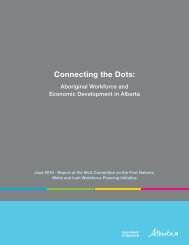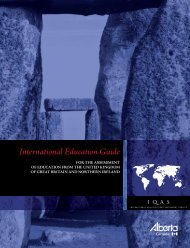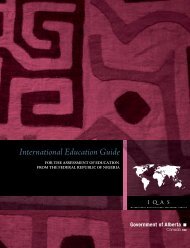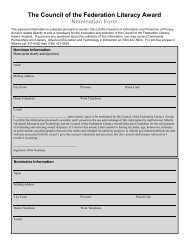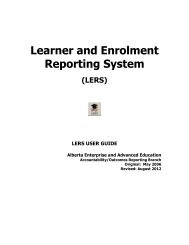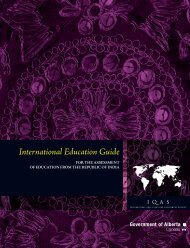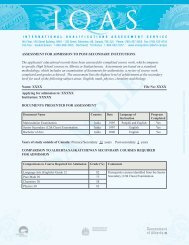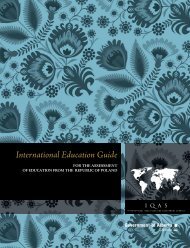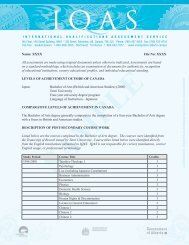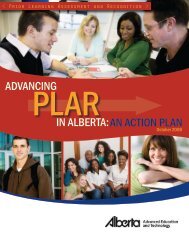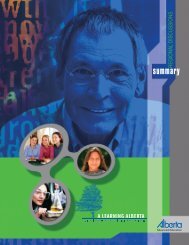International Education Guide - Enterprise and Advanced Education ...
International Education Guide - Enterprise and Advanced Education ...
International Education Guide - Enterprise and Advanced Education ...
You also want an ePaper? Increase the reach of your titles
YUMPU automatically turns print PDFs into web optimized ePapers that Google loves.
.2<br />
INTERNATIONAL EDUCATION GUIDE for the assessment of education from the Islamic Republic of Pakistan<br />
Canada <strong>and</strong> Pakistan enjoy strong economic, social<br />
<strong>and</strong> cultural ties. The Pakistani community in Canada<br />
is estimated at more than 300,000.<br />
Figure 2. Urdu Alphabet<br />
Throughout history the area occupied by present-day<br />
Pakistan has experienced repeated invasions <strong>and</strong> large-scale<br />
migrations. Therefore the people of Pakistan are diverse in<br />
terms of ethnicity, cultural tradition <strong>and</strong> religious affiliation,<br />
<strong>and</strong> they speak many different languages <strong>and</strong> dialects.<br />
Pakistan is among Canada’s top five sources of<br />
immigrants, with more than 22,000 visas issued in 2006.<br />
The great majority of Pakistanis—over 96 per cent—are<br />
Muslim, of whom about 95 per cent are Sunni <strong>and</strong> 5 per<br />
cent are Shia. Qadiani (0.2 per cent of the population),<br />
also known as Ahmadi, is a small but influential sect that<br />
maintains some Islamic beliefs but is considered non-Muslim<br />
by law. There are also small minorities of Hindus (1.6 per<br />
cent of the population) <strong>and</strong> Christians (1.6 per cent).<br />
The national language of Pakistan is Urdu, an Indo-Aryan<br />
language belonging to the Indo-European language family.<br />
It uses a version of the Perso-Arabic script with 39 basic<br />
letters <strong>and</strong>, like Arabic <strong>and</strong> Persian, is written from right to<br />
left. Much Urdu vocabulary comes from Persian <strong>and</strong> Arabic.<br />
Urdu is closely related to Hindi, the national language of<br />
India. The two languages have virtually identical grammar<br />
<strong>and</strong> vocabularies, although Hindi has its roots in Sanskrit<br />
<strong>and</strong> is written in the Devanagari script. Figure 2 <strong>and</strong> Table<br />
1 show the Urdu alphabet <strong>and</strong> numbers along with the<br />
Devanagari script <strong>and</strong> English transliteration.<br />
Table 1. Urdu Numbers, 1 through 10<br />
Number Urdu English transliteration<br />
1<br />
۱<br />
ek<br />
2 ۲<br />
do<br />
3 ۳<br />
teen<br />
4 ۴<br />
char<br />
5 ۵<br />
panch<br />
6 ۶<br />
chae<br />
7 ۷<br />
sath<br />
8 ۸<br />
aath<br />
9 ۹<br />
nao<br />
10 ۱۰<br />
das<br />
While only a small minority of the population speak it<br />
as their first language, Urdu serves as the lingua franca<br />
of the country <strong>and</strong> is spoken as a second language by<br />
most of the populace. English also has official status<br />
<strong>and</strong>, along with Urdu, is widely used in government,<br />
commerce <strong>and</strong> higher education.<br />
Pakistan’s literacy rate (defined, for any language, as the<br />
ability to read a newspaper <strong>and</strong> write a simple letter) is<br />
around 53 per cent.




